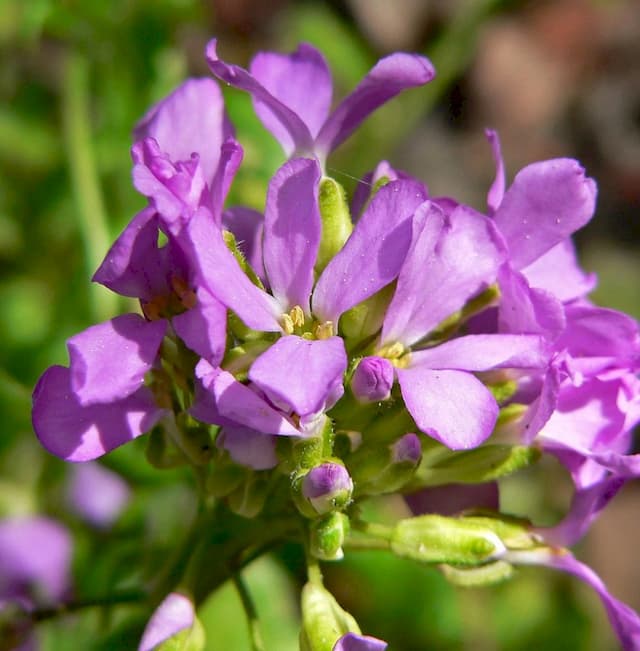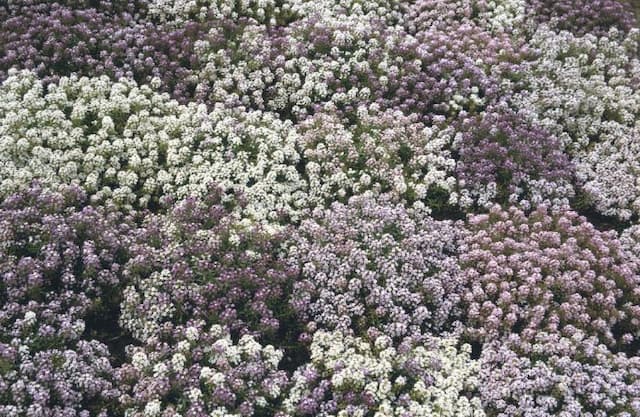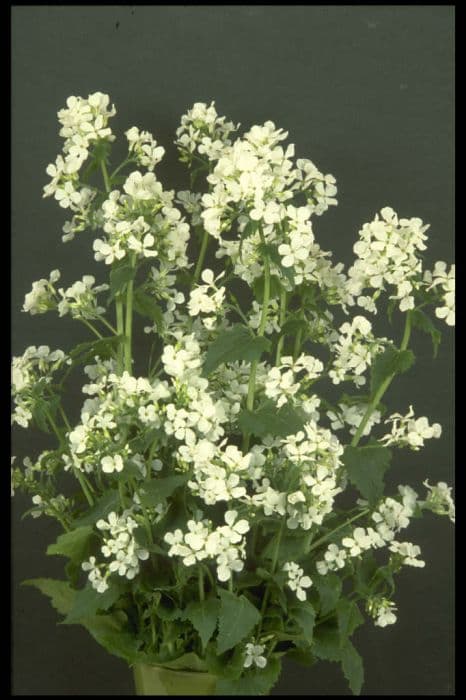Candytuft Iberis 'Masterpiece' (PBR)

ABOUT
Iberis 'Masterpiece', commonly known as Candytuft 'Masterpiece', is a charming evergreen perennial that graces gardens with its beauty. While we won't specify exact sizes, know that this plant presents itself in a bushy, compact manner, typically maintaining a mounded form. Its leaves are a bright, glossy green and tend to be lance-shaped, providing an attractive backdrop throughout the year. The star of the show, however, is its blooms. Candytuft 'Masterpiece' produces a profusion of vibrant, pure white flowers that cluster densely at the tips of the stems. Each bloom is small and delicate, with a four-petal arrangement that creates a frothy and lush appearance when many are viewed together. These flowers have a notable, extended blooming period, often starting in late spring and continuing into early summer, bringing extended interest to the planting area. In terms of its use in the garden, Candytuft 'Masterpiece' is versatile, often used as ground cover, in rock gardens, over walls, or in borders. Its showy flowers attract pollinators such as bees and butterflies, adding to its charm and making it a valued addition to wildlife gardens. The contrast between the foliage and the bright white flowers can provide a striking visual effect, especially when planted en masse. The plant's resilience and evergreen foliage also contribute to its popularity, as it provides year-round interest regardless of flowering status. Overall, Iberis 'Masterpiece' is a delightful plant that offers beauty, versatility, and the allure of an extended and vibrant bloom period.
About this plant
 Names
NamesFamily
Brassicaceae
Synonyms
Candytuft
Common names
Iberis 'Masterpiece' (PBR)
 Toxicity
ToxicityTo humans
The plant commonly known as candytuft, which includes the Iberis 'Masterpiece' (PBR), is not considered toxic to humans. In general, candytuft does not contain substances known to cause serious harm if ingested. However, it is always advisable to avoid eating ornamental plants as they are not intended for consumption, and individual allergic reactions or sensitivities could occur.
To pets
Candytuft, including the Iberis 'Masterpiece' (PBR), is not known to be toxic to pets. It is not listed among the common poisonous plants for dogs and cats, suggesting that it does not contain harmful toxins that would cause serious illness or fatalities in pets. However, consumption of non-food plants can sometimes lead to mild gastrointestinal upset in some animals, so it is still best to prevent pets from ingesting this plant.
 Characteristics
CharacteristicsLife cycle
Perennials
Foliage type
Evergreen
Color of leaves
Dark green
Flower color
White
Height
1 foot (30 cm)
Spread
1 foot (30 cm)
Plant type
Herb
Hardiness zones
5-9
Native area
Mediterranean
Benefits
 General Benefits
General Benefits- Attracts Pollinators: The Iberis 'Masterpiece' is known for attracting bees and butterflies, which are essential for pollination and maintaining healthy ecosystems.
- Low Maintenance: This plant is considered low maintenance due to its minimal needs for water and fertilization once established, making it ideal for gardeners looking for easy-care options.
- Drought Tolerant: Once established, Iberis 'Masterpiece' has a good tolerance for dry conditions, making it suitable for gardens in arid climates or drought-prone areas.
- Evergreen Foliage: With its evergreen leaves, this plant provides year-round color and texture to a garden, keeping it lively even in the winter months.
- Ground Cover: Its growth habit makes it an excellent option for ground cover, preventing weeds and helping to protect the soil from erosion.
- Border Plant: The compact size and attractive flowers of Iberis 'Masterpiece' make it a great choice for creating borders along paths or garden beds.
- Spring Blooms: It produces abundant white flowers in spring, adding a burst of color to the garden during this season.
- Rapid Growth: It grows relatively quickly, allowing gardeners to establish a full, lush appearance in a relatively short period of time.
- Rock Gardens: Its tolerance for poor soil and its mounding habit make it a perfect fit for rock gardens, where it can thrive in the well-draining conditions.
- Container Gardening: Iberis 'Masterpiece' can also be grown in containers, making it a versatile plant for patios and balconies.
 Medical Properties
Medical PropertiesThis plant is not used for medical purposes.
 Air-purifying Qualities
Air-purifying QualitiesThis plant is not specifically known for air purifying qualities.
 Other Uses
Other Uses- Candytuft, such as Iberis 'Masterpiece', can be used in educational settings for studying plant growth and adaptation, as it can readily adapt to various soil types.
- The dense, evergreen foliage of Candytuft can act as a ground cover in landscaping to suppress weeds and reduce garden maintenance.
- Candytuft's ability to attract beneficial insects like bees and butterflies can be utilized in companion planting to improve the pollination of vegetable gardens and orchards.
- Dried Candytuft flowers can add an ornamental touch to crafts, such as wreaths or dried flower arrangements, due to their longevity and structure.
- The white flowers of Candytuft may be used as a natural dye source for textiles, yielding soft and subtle shades.
- Candytuft plants can serve as an indicator species for studying ecosystem health and soil conditions in conservation areas.
- When used in a sensory garden, the diverse textures and vibrant colors of Candytuft can provide a tactile and visual experience for visitors.
- Candytuft's pattern of growth can be studied in biomimicry designs, potentially influencing the development of low-maintenance green technology or architecture.
- Planting Candytuft near patios or walkways provides a pleasant, natural fragrance, enhancing the sensory appeal of outdoor living spaces.
- Using Candytuft in urban green roofs can help reduce the heat island effect in cities while providing habitat for urban wildlife.
Interesting Facts
 Feng Shui
Feng ShuiThe plant Iberis, commonly known as Candytuft, is not used in Feng Shui practice.
 Zodiac Sign Compitability
Zodiac Sign CompitabilityThe plant Iberis, commonly known as Candytuft, is not used in astrology practice.
 Plant Symbolism
Plant Symbolism- Affection: Iberis 'Masterpiece', commonly known as Candytuft, often symbolizes affection and warmth due to its dense clusters of flowers that create a cushion-like appearance, suggesting a sense of coziness and care.
- Indifference: In some historical contexts, Candytuft has been associated with indifference, potentially originating from the flower's hardy nature and ability to thrive with minimal attention.
- Beauty: The bright white flowers of Candytuft can symbolize beauty and purity, as its striking presence in gardens and floral arrangements often draws the eye and evokes a sense of admiration.
 Water
WaterCandytuft 'Masterpiece' prefers moderate watering, with a thorough soaking followed by a period of allowing the soil to partially dry out between watering sessions. Generally, water your Candytuft with approximately 1 gallon of water every week during the active growing season, and reduce the amount during the winter or dormant period. Be careful not to overwater as this plant does not like to sit in wet soils. Ensure that the plant has good drainage to prevent root rot. Adjust the watering schedule based on your local climate conditions, such as increased frequency during hot, dry spells and decreased during periods of rain or cool weather.
 Light
LightCandytuft 'Masterpiece' thrives best in full sun to partial shade. Place it in a location where it will receive at least 6 hours of sunlight per day to encourage plentiful blossoms. However, in areas with intense afternoon sun, providing some light afternoon shade can help protect the plant from heat stress. Full morning sun with dappled afternoon light is ideal for helping the Candytuft's blooms last longer and maintain vibrant colors.
 Temperature
TemperatureCandytuft 'Masterpiece' can survive in temperatures as low as 30°F (-1°C) and can tolerate highs up to around 85°F (29°C). The ideal temperature range for this plant is between 60°F and 75°F (15°C to 24°C). It is not a plant suited for tropical climates and prefers the cooler temperatures of temperate regions. Candytuft can handle a light frost but needs protection from severe freezes.
 Pruning
PruningTrim Candytuft 'Masterpiece' after it finishes blooming, typically in the late spring or early summer, to maintain its shape and encourage dense, bushy growth. Pruning helps remove spent flowers and can invigorate the plant for potential reblooming. Prune no more than one-third of the plant at a time to avoid stressing it. The best time for pruning is right after the majority of its flowers have faded.
 Cleaning
CleaningAs needed
 Soil
SoilCandytuft 'Masterpiece' thrives in well-drained soil enriched with organic matter. A mix of two parts garden soil, one part perlite, and one part compost is ideal. This plant prefers a slightly alkaline soil pH ranging from 7.0 to 8.0.
 Repotting
RepottingCandytuft 'Masterpiece' generally does not require frequent repotting and can be done every 2-3 years, or when it outgrows its container.
 Humidity & Misting
Humidity & MistingCandytuft 'Masterpiece' is tolerant of a range of humidity levels and does well in average garden conditions; however, avoid overly humid environments as they may promote disease.
 Suitable locations
Suitable locationsIndoor
Provide bright light and well-draining soil mix.
Outdoor
Sun, well-drained soil, water when dry.
Hardiness zone
3-9 USDA
 Life cycle
Life cycleIberis 'Masterpiece', commonly known as Candytuft, begins its life cycle with seed germination, typically in early spring, where the seeds need light to germinate effectively. Seedlings emerge and develop into the vegetative stage, forming a low mound of narrow, glossy leaves, which provides the foundational structure of the plant. Throughout late spring to early summer, it enters the flowering stage, producing clusters of large white flowers that are notably attractive to pollinators such as bees and butterflies. After pollination and throughout the end of summer, the flowers fade and the plant produces seed pods, which, when mature, release seeds to complete the reproductive cycle. In the autumn, the evergreen foliage of the Candytuft offers visual interest even as the plant enters dormancy, conserving energy for the next growing season. Pruning after flowering helps maintain plant vigor and encourages a compact growth habit, preparing Candytuft for overwintering and subsequent regeneration in the following spring.
 Propogation
PropogationPropogation time
Spring-Early Summer
The Iberis 'Masterpiece' (PBR), commonly known as the perennial candytuft, is often propagated through cuttings. This popular method involves taking a cutting of about 4-6 inches (10-15 cm) from a healthy parent plant during the early summer months when growth is vigorous. The cut end of the cutting is then dipped in rooting hormone to stimulate root growth and planted in a well-draining soil mix. To retain moisture and encourage rooting, the pot with the cutting can be covered with a plastic bag or placed in a propagator with bottom heat. It generally takes a few weeks for the cutting to show signs of root development, after which it can be transplanted to a more permanent location.


![Aubrieta [Axcent Lilac]](/_next/image?url=https%3A%2F%2Fplants-admin.emdemapps.com%2Fimages%2Fplants%2F%2Fimages%2F604b5e2430fac.png&w=640&q=75)






